Transport law of soil heavy metal Zn with soil depth in the paddy field
This study analyzed the data of the paddy field for irrigation tests with irrigation quota of 75, 150, 225 and 300 m3/hm2. The average value of Zn content in soil of 0, 10, 20, 30, 40, 40, 60, 70, 80, 90 and 100 cm was calculated for each soil depth measured. According to the statistical analysis of the original data, the migration law of Zn content, its variation and the rate of change with the soil depth are shown in Figs. 1, 2 and 3.
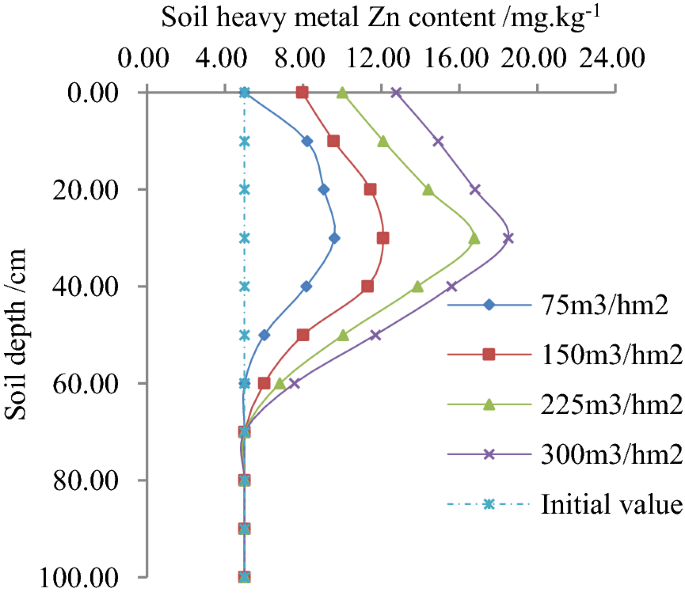
Relationship between soil heavy metal Zn and soil depth.
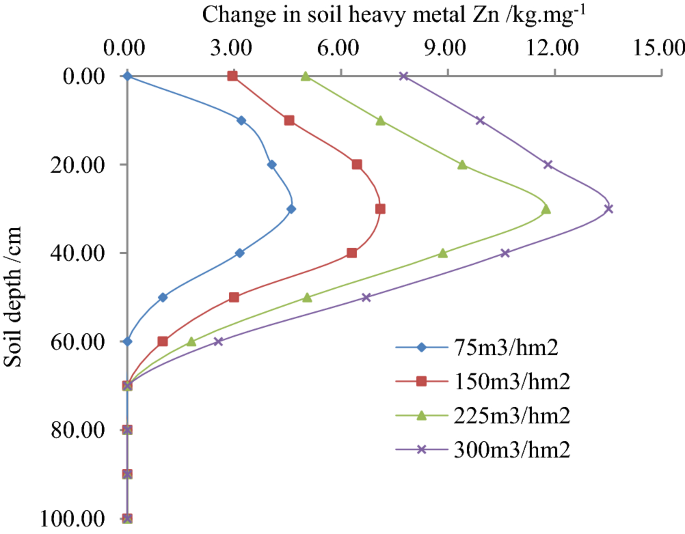
Relationship between soil heavy metal Zn variation and soil depth.
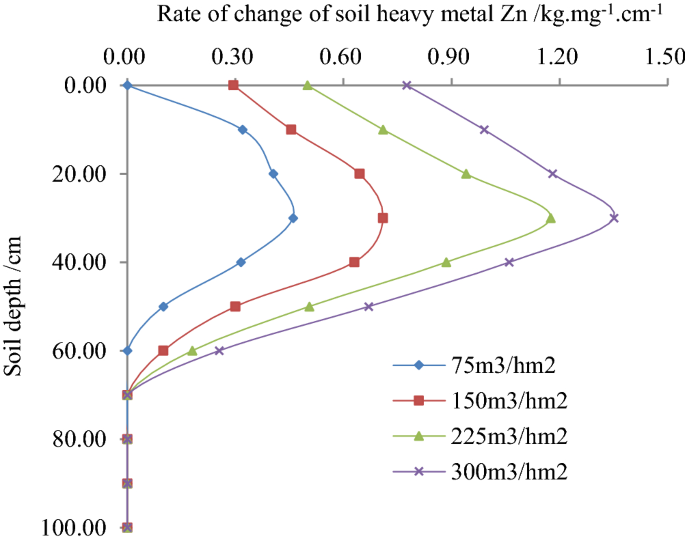
relationship between the rate of the change of soil heavy metal Zn and soil depth.
According to Fig. 1, when the irrigation quota reclaimed water was the same in different test segments, initially the content of Zn in the soil found to increase and hereafter decrease with the increase of soil depth, and finally found to be stable compared to the initial value. According to the experiments, when the irrigation quota reclaimed water was 75, 150 and 225 m3/hm2, the average content of Zn in soil decreased by 39.73%, 26.70%, and 11.76% respectively compared to 300 m3/hm2. Additionally, with the same soil depth, the content of Zn in soil found to increase with the increase of irrigation quota. Likewise, when the soil depth was 30 cm and the irrigation quota reclaimed water was 75, 150 and 225 m3/hm2, and the content of Zn was reduced by 48.11%, 34.59% and 9.46%, respectively compared to 300 m3/hm2.
It is observed from Fig. 2 that with the same irrigation quota reclaimed water, initially, the variation of Zn found to increase, and hereafter decreased with the increase of soil depth, and finally found to be stable. According to the study, when the reclaimed water irrigation quota was 75, 150, 225 and 300 m3/hm2, the soil Zn variation was the largest for the soil depth of 30 cm, and its values were 4.60, 7.10, 11.75 and 13.50 mg/kg, respectively. The changes of Zn in soil with the irrigation quota of 75, 150 and 225 m3/hm2 were found 74.53%, 50.09%, and 22.07% respectively lower than irrigation quota of 300 m3/hm2. Additionally, with the same soil depth, the variation of Zn in soil found to increase with the increase of irrigation quota. Likewise, when the soil depth was 30 cm and the irrigation quota reclaimed water was 75, 150 and 225 m3/hm2, the variation of Zn decreased by 65.93%, 47.71%, and 12.96% compared to the irrigation quota of 300 m3/hm2.
It is observed from Fig. 3, initially, the rate of the change of Zn in soil found to increase and hereafter decreased with the increase of soil depth, and finally found to be stable. According to the experiments, when the irrigation rate of reclaimed water was 75, 150, 225 and 300 m3/hm2, the change rate of Zn in the soil with a soil depth of 30 cm reached maximum, and the values were found 0.46, 0.71, 1.18 and 1.35 mg/kg.cm respectively. Additionally, when the soil depth was 30 cm, the rate of changes of Zn in the soil with the irrigation water quota of 75, 150, 225 and 300 m3/hm2 were found the highest, and the values were 0.46, 0.71, 1.18 and 1.35 mg/kg.cm, respectively. The changes of Zn in the soil were found 74.48%, 50.00%, and 21.93% lower than of 300 m3/hm2. The values are compared with the irrigation rates of the reclaimed water by 75, 150 and 225 m3/hm2. Likewise, with the same soil depth, the rate of changes of Zn in the soil found to increase with the increase of irrigation water quota. Thus, when the soil depth was 30 cm, the changes of Zn in the soil were found at 65.93%, 47.41%, and 12.96% lower than of 300 m3/hm2. The values are compared with the irrigation water quota of reclaimed water by 75, 150 and 225 m3/hm2.
The main reason was expected that the soil colloid was negatively charged, while the soil Zn2+ was positively charged. The two metals gathered near to the root system after adsorption, and the reclaimed water was washed by water and moved to the deep soil after irrigation. According to the analyses, the content of Zn, its variation, rate of change, soil depth and irrigation quota conformed to the nonlinear law under different irrigation quotas of reclaimed water in the paddy field14.
We assumed that: (xleft( {h,m} right) = ah^{b} m^{c}), (Delta x^{prime}left( {h,m} right) = a^{prime}h^{{b^{prime}}} m^{{c^{prime}}}), (Delta x^{primeprime}left( {h,m} right) = a^{primeprime}h^{{b^{primeprime}}} m^{{c^{primeprime}}}).
The nonlinear regression of the experimental data in Figs. 1, 2 and 3 obtained as follows:
$$xleft( {h,m} right) = ah^{b} m^{c} = 4.6040h^{ – 0.3640} m^{0.3840} ;;;;;;;R^{2} = 0.9567$$
(1)
$$Delta x^{prime}left( {h,m} right) = a^{prime}h^{{b^{prime}}} m^{{c^{prime}}} = 0.3380h^{ – 0.6210} m^{0.8970} ;;;;R^{2} = 0.9507$$
(2)
$$Delta x^{primeprime}left( {h,m} right) = a^{primeprime}h^{{b^{primeprime}}} m^{{c^{primeprime}}} = 0.0349h^{ – 0.6209} m^{0.8921} ;;;;;R^{2} = 0.9469$$
(3)
In types: (xleft( {h,m} right))—Content of heavy metal Zn in soil, (mg/kg); (Delta x^{prime}left( {h,m} right))—Variation of heavy metal Zn in soil, (mg/kg);(Delta x^{prime}left( {h,m} right) = left| {xleft( {h,m} right) – xleft( {h_{0} ,m_{0} } right)} right|);(Delta x^{primeprime}left( {h,m} right))— The rate of the change of soil heavy metal Zn, (mg/(kg cdot cm));(Delta x^{primeprime}left( {h,m} right) = {{Delta x^{prime}left( {h,m} right)} mathord{left/ {vphantom {{Delta x^{prime}left( {h,m} right)} h}} right. kern-nulldelimiterspace} h});(xleft( {h_{0} ,m_{0} } right))—Initial value of soil heavy metal Zn, (mg/kg);(a,b,c,a^{prime},b^{prime},c^{prime},a^{primeprime},b^{primeprime},c^{primeprime})—fit coefficient; (h)—Soil depth, cm; (m)—irrigating water quota, m3/hm2.
Correlation analysis was carried out for Eqs. (1) – (3) respectively. The standard errors of (a,b,c) were found 0.6680, 0.0580 and 0.1030, and the values of (a,b,c) estimated with 95% confidence intervals were (− 0.7850, 9.9920), (− 0.4810, − 0.2470) and (0.1770, 0.5910). The standard errors of (a^{prime},b^{prime},c^{prime}) were 0.5460, 0.1260 and 0.2860. The values of (a^{prime},b^{prime},c^{prime}) estimated with 95% confidence intervals were (− 0.7640, 1.4410), (− 0.8760, − 0.3660) and (0.3190, 1.4750). The standard errors of (a^{primeprime},b^{primeprime},c^{primeprime}) were 0.0560, 0.1259 and 0.2861, respectively, and the values of (a^{primeprime},b^{primeprime},c^{primeprime}) estimated with 95% confidence intervals were (− 0.0780, 0.1480), (− 0.8750, − 0.3660) and (0.3150, 1.4690).
The correlation coefficient of Eqs. (1) – (3) was greater than the critical correlation coefficient of 0.9400, and their standard errors were insignificant, however, the correlation coefficient passed the significance test and statistically significant. By taking logarithms of both sides of the regression Eqs. (1) – (3), this study found that initially the content of Zn in soil changes and conversion rates increased, and hereafter decreased with the increase of soil depth, and finally found to be stable. The changes in Zn contents are compared with the increase of the irrigation quota. The findings were consistent with the rule of change shown in Figs. 1, 2 and 3. According to the statistical analysis, the mean relative error between the standard and measured value of Zn contents, its variation and rate of changes were found 8.909%, 5.221% and 6.096%, respectively. The findings showed that Zn contents in soil, its variation and rate of changes reflected the migration law accordingly with soil depth and irrigation quota in the paddy field.
The migration law of soil heavy metal Zn with rice plant growth time
Figures 4, 5 and 6 respectively show the relationship between the content of Zn, its quantity change and the rate of changes with plant growth time under different irrigation quotas of reclaimed water in the paddy field.
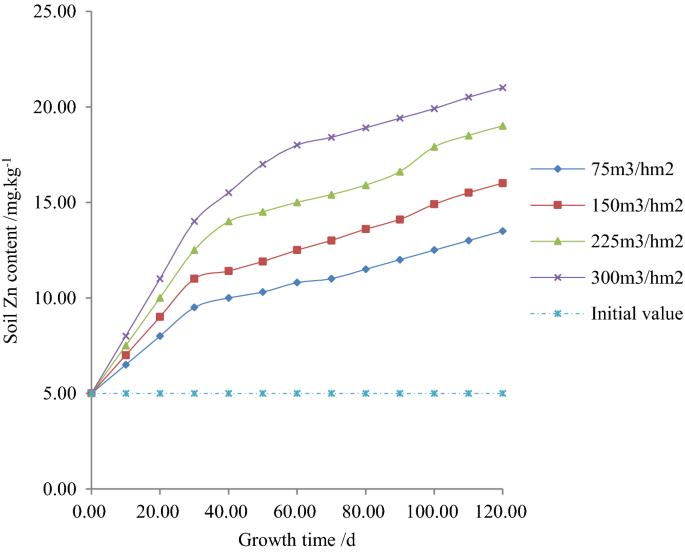
Relationship between soil heavy metal, Zn content and plant growth time.
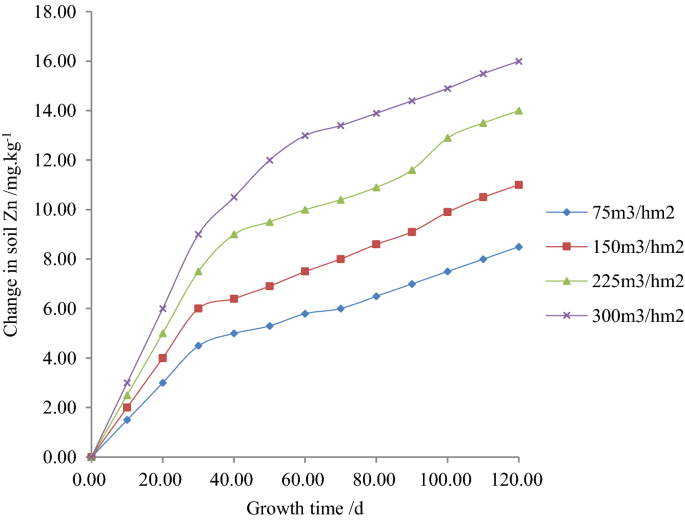
Relationship between the change of soil heavy metal, Zn and plant growth time.
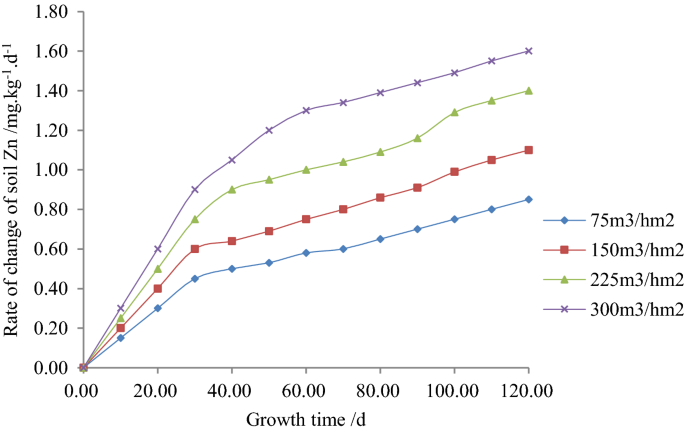
Relationship between the rate of change of soil heavy metal, Zn and plant growth time.
According to experiments and Fig. 4, it is shown that when the irrigation quota of reclaimed water was the same, the content of Zn in soil increased with plant growth time. It is obvious that when the fertility time was 120 days, the content of Zn in soil reached the maximum with the irrigation water quota of 75, 150, 225 and 300 m3/hm2. The values of Zn in such experiments were found 13.51, 16.01, 19.02 and 20.98 mg/kg. During the whole growth period, the average content of Zn in soil was decreased by 35.32%, 25.01% and 11.99% when the irrigation quotas of reclaimed water were 75, 150 and 225 m3/hm2 compared to 300 m3/hm2. Furthermore, when the plant growth time was the same, the content of Zn in soil increased with the increase in irrigation quota. According to the experiments, when the fertility period was 120 days, the content of Zn in soil was decreased by 35.71%, 23.81%, and 9.52% when the irrigation quotas of reclaimed water were 75, 150 and 225 m3/hm2 respectively compared to 300m3/hm2.
According to experiments and Fig. 5, it is revealed that when the irrigation quota of reclaimed water was the same, the quantity change of Zn in soil increased with plant growth time. It is obvious that when the fertility time was 120 days, the content of Zn in soil reached the maximum with the irrigation water quota of reclaimed water of 75, 150, 225 and 300 m3/hm2, and the values were found 8.49, 10.98, 14.01, and 16.03 mg/kg respectively. However, the changes of Zn with the irrigation quota of reclaimed water of 75, 150 and 225 m3/hm2 were found 51.54%, 36.51%, and 17.49% lower compared to 300 m3/hm2. Nevertheless, with the same plant growth time, the quantity change of Zn increased with the increase in irrigation quota. Finally, it is obvious that when the fertility time was 120 days, the changes of Zn with the irrigation quota of reclaimed water of 75, 150 and 225 m3/hm2 were found 46.88%, 31.25%, and 12.50% lower than those in 300 m3/hm2.
According to experiments and Fig. 6, it is obvious that when the irrigation quota of reclaimed water was the same, the rate of the change of Zn in soil increased with the plant growth time. It is obvious that when the fertility time was 120 days, the content of Zn in soil reached the maximum with the irrigation water quota of reclaimed water of 75, 150, 225 and 300 m3/hm2 and the values were found 0.84, 1.09, 1.38 and 1.58 mg/(kg∙d) respectively. However, when the irrigation quotas of reclaimed water were 75, 150 and 225 m3/hm2, the rate of the change of Zn in soil was found 51.59%, 36.56%, and 17.57% lower than that of 300 m3/hm2. Nevertheless, with the same plant growth time, the rate of change of Zn in soil increased with the increase in irrigation water quota. Finally, it is obvious that when the plant growth time was 120 days and with irrigation water quota of 75, 150 and 225 m3/hm2, the rate of the change of Zn in soil decreased by 46.88%, 31.25%, and 12.49% respectively compared to 300 m3/hm2.
This study confirmed that the amount of Zn absorbed by the rice root system under irrigation reclaimed water was less. However, due to the increase of irrigation time, Zn in the soil found to increase with the plant growth time. According to the analyses, the content of Zn and its plant growth time, rate of the quantity change and irrigation quota confirmed nonlinear law under different irrigation quota of reclaimed water.
We assumed that: (xleft( {t,m} right) = dt^{e} m^{f}),(Delta x^{prime}left( {t,m} right) = d^{prime}t^{{e^{prime}}} m^{{f^{prime}}}) and (Delta x^{primeprime}left( {t,m} right) = d^{primeprime}t^{{e^{primeprime}}} m^{{f^{primeprime}}}).
The nonlinear regression of the experimental data in Figs. 4, 5 and 6 obtained as follows:
$$xleft( {t,m} right) = dt^{e} m^{f} = 0.6310t^{0.3230} m^{0.3430} ;;;;R^{2} = 0.9875$$
(4)
$$Delta x^{prime}left( {t,m} right) = d^{prime}t^{{e^{prime}}} m^{{f^{prime}}} = 0.0618t^{0.5149} m^{0.5480} ;;;;;R^{2} = 0.9780$$
(5)
$$Delta x^{primeprime}left( {t,m} right) = d^{primeprime}t^{{e^{primeprime}}} m^{{f^{primeprime}}} = 0.00601t^{0.5151} m^{0.5479} ;;;;R^{2} = 0.9786$$
(6)
In types: (xleft( {t,m} right))—Content of heavy metal Zn in soil, (mg/kg); (Delta x^{prime}left( {t,m} right))—Variation of heavy metal Zn in soil, (mg/kg);(Delta x^{prime}left( {t,m} right) = left| {xleft( {t,m} right) – xleft( {t_{0} ,m_{0} } right)} right|);(Delta x^{primeprime}left( {t,m} right))—The rate of the change of soil heavy metal Zn, (mg/(kg cdot d));(Delta x^{primeprime}left( {t,m} right) = {{Delta x^{prime}left( {t,m} right)} mathord{left/ {vphantom {{Delta x^{prime}left( {t,m} right)} t}} right. kern-nulldelimiterspace} t});(xleft( {t_{0} ,m_{0} } right))—Initial value of soil heavy metal Zn, (mg/kg);(d,e,f,d^{prime},e^{prime},f^{prime},d^{primeprime},e^{primeprime},f^{primeprime})—fit coefficient; (t)—Plant growth time, d; (m)—irrigating water quota, m3/hm2.
The correlation analysis was conducted for Eqs. (4) – (6) respectively. The standard errors of (d,e,f) were found 0.1380, 0.0280 and 0.0350 and the values estimated with 95% confidence intervals were (0.3530, 0.9080), (0.2660, 0.3800) and (0.2740, 0.4130). The standard errors of (d^{prime},e^{prime},f^{prime}) were found 0.0100, 0.0210 and 0.0240, and the values estimated with 95% confidence intervals were (0.0420, 0.0820), (0.4730, 0.5580) and (0.4990, 0.5970). The standard errors of (d^{primeprime},e^{primeprime},f^{primeprime}) were found 0.0010, 0.0218 and 0.0237, and the values estimated with 95% confidence intervals were (0.0040, 0.0080), (0.4730, 0.5580) and (0.4990, 0.5970).
The correlation coefficient of Eqs. (4) – (6) was greater than the critical correlation coefficient 0.9700, and their standard errors were insignificant, however, the correlation coefficient found statistically significant. By taking logarithms of both sides of a regression Eqs. (4) – (6), this study found that initially, the contents of Zn in soil and conversion rates increased with the increase of plant growth time and irrigation quota. The findings were consistent with the rule of change shown in Figs. 4, 5 and 6. According to the statistical analysis, the mean value of the relative error between the standard statistical and measured value of Zn content in the soil, its variation and the rate of change was 3.0390%, 0.2774%, and 2.9574%, respectively. The findings showed that Zn content in the soil, its variation and rate of change reflected the migration law duly with plant growth time and irrigation quota in the paddy field.
Source: Ecology - nature.com


